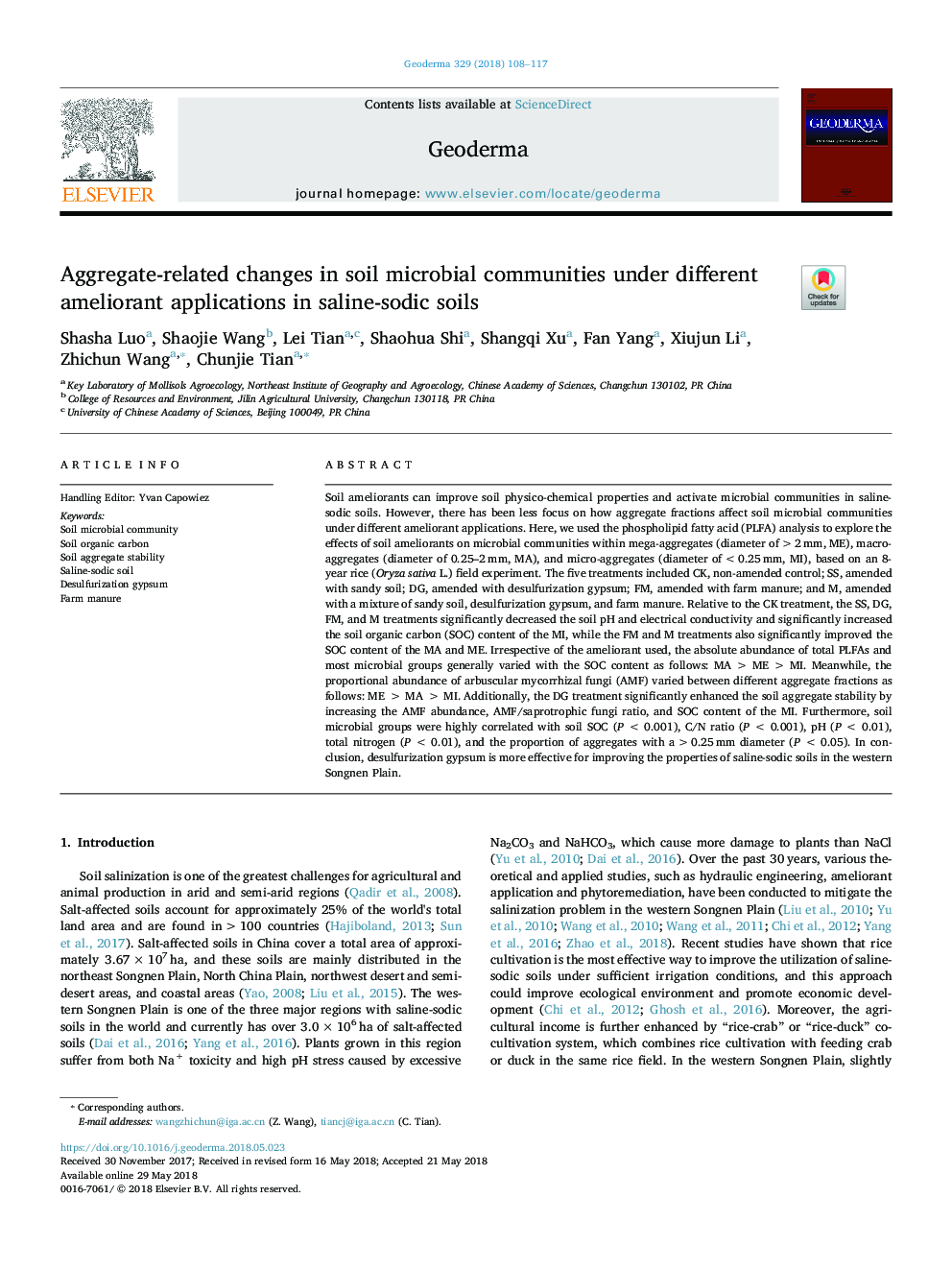| کد مقاله | کد نشریه | سال انتشار | مقاله انگلیسی | نسخه تمام متن |
|---|---|---|---|---|
| 8893936 | 1629388 | 2018 | 10 صفحه PDF | دانلود رایگان |
عنوان انگلیسی مقاله ISI
Aggregate-related changes in soil microbial communities under different ameliorant applications in saline-sodic soils
ترجمه فارسی عنوان
تغییرات مرتبط با ترکیبات در جوامع میکروبی خاک تحت برنامه های کاربردی مختلف در خاک خاکی
دانلود مقاله + سفارش ترجمه
دانلود مقاله ISI انگلیسی
رایگان برای ایرانیان
کلمات کلیدی
جامعه میکروبی خاک، کربن آلاینده خاک پایداری مینرال خاک، خاک سالین-سدیم، گچ سولفوریزاسیون، کودهای مزرعه،
موضوعات مرتبط
مهندسی و علوم پایه
علوم زمین و سیارات
فرآیندهای سطح زمین
چکیده انگلیسی
Soil ameliorants can improve soil physico-chemical properties and activate microbial communities in saline-sodic soils. However, there has been less focus on how aggregate fractions affect soil microbial communities under different ameliorant applications. Here, we used the phospholipid fatty acid (PLFA) analysis to explore the effects of soil ameliorants on microbial communities within mega-aggregates (diameter of >2â¯mm, ME), macro-aggregates (diameter of 0.25-2â¯mm, MA), and micro-aggregates (diameter of <0.25â¯mm, MI), based on an 8-year rice (Oryza sativa L.) field experiment. The five treatments included CK, non-amended control; SS, amended with sandy soil; DG, amended with desulfurization gypsum; FM, amended with farm manure; and M, amended with a mixture of sandy soil, desulfurization gypsum, and farm manure. Relative to the CK treatment, the SS, DG, FM, and M treatments significantly decreased the soil pH and electrical conductivity and significantly increased the soil organic carbon (SOC) content of the MI, while the FM and M treatments also significantly improved the SOC content of the MA and ME. Irrespective of the ameliorant used, the absolute abundance of total PLFAs and most microbial groups generally varied with the SOC content as follows: MAâ¯>â¯MEâ¯>â¯MI. Meanwhile, the proportional abundance of arbuscular mycorrhizal fungi (AMF) varied between different aggregate fractions as follows: MEâ¯>â¯MAâ¯>â¯MI. Additionally, the DG treatment significantly enhanced the soil aggregate stability by increasing the AMF abundance, AMF/saprotrophic fungi ratio, and SOC content of the MI. Furthermore, soil microbial groups were highly correlated with soil SOC (Pâ¯<â¯0.001), C/N ratio (Pâ¯<â¯0.001), pH (Pâ¯<â¯0.01), total nitrogen (Pâ¯<â¯0.01), and the proportion of aggregates with a >0.25â¯mm diameter (Pâ¯<â¯0.05). In conclusion, desulfurization gypsum is more effective for improving the properties of saline-sodic soils in the western Songnen Plain.
ناشر
Database: Elsevier - ScienceDirect (ساینس دایرکت)
Journal: Geoderma - Volume 329, 1 November 2018, Pages 108-117
Journal: Geoderma - Volume 329, 1 November 2018, Pages 108-117
نویسندگان
Shasha Luo, Shaojie Wang, Lei Tian, Shaohua Shi, Shangqi Xu, Fan Yang, Xiujun Li, Zhichun Wang, Chunjie Tian,
